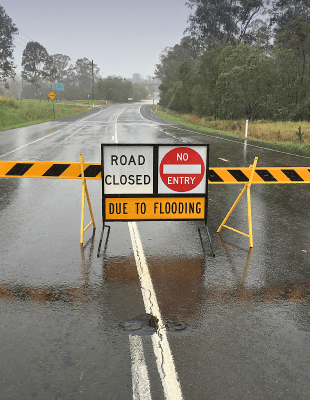Australia is one of the most extreme places in the world. Our mega bushfires, major floods and extensive droughts have all captured global headlines. We seem to be regularly cleaning up after one natural disaster or another.
It’s all part of Australia’s hydrological cycle. Or, if you consider how we (and to be fair, most countries) approach drought preparedness, it’s more like our hydro-illogical cycle.
We plan and build desalination plants in the middle of drought. They come online when it’s flooding. During months of flooding, we start building dams that can stand empty for years once they are complete because we’re back in drought. It’s a vicious cycle of knee jerk reactions.
And it’s a challenge facing all kinds of Australian cities and towns. For some, it’s a challenge they have been facing since day one.
Brisbane, Australia’s most flood-prone metropolis was founded in 1824. The Victorian regional centre of Bendigo, also subject to flooding, was established in 1851. The township of Lismore in northern NSW, has experienced annual ‘nuisance’ floods since it was established in 1856. However, they have experienced 29 floods of 9.9 metres or higher since 1870. The most recent floods of 2022 have been particularly devastating. Almost 200 years later and we’re still coming to grips with how to live alongside our impressive waterways.
Flood mitigation on its own is clearly not the answer. Rigid infrastructure designed to defend and repel isn’t always up to task against the relentless onslaught of natural forces. Instead, we must better adapt to our environment and current climate – which in turn will help us be better prepared for future climate challenges.
Climate adaptation means living with nature, not fighting against it. But when you live in one of the most extreme environments in the world, what does climate adaptation even look like?
In Brisbane, we know the CBD will flood. We can’t keep the flood waters out, so we are increasingly designing our buildings to be flood resilient. That means allowing flood waters to safely flow through buildings with the least amount of damage for the fastest recovery time. Choosing materials that won’t need to be replaced in the event of a flood, like concrete and hard timbers, and placing electrical outlets and technology above flood levels are practical applications on a building by building basis.
Many cities are taking this flood resiliency many steps further to become ‘sponge’ cities. For example, our work with Wuhan in China took a nature-based approach to resilience by investing in urban gardens, parks and green spaces, and the creation of artificial lakes. When it rains, water is absorbed or redirected away from populated areas to water channels that can safely handle large volumes of water during flood events. Of course, the investment in greenery and providing the space for flood waters to flow to has added benefits for the city, including cooler temperatures, better air quality, improved local biodiversity and new spaces for the community to enjoy. The City of Wuhan now sits more comfortably in its environment.
But that’s just one approach. What works for Brisbane won’t necessarily work for Lismore. With nearly 45,000 people, a significant portion of Lismore’s commercial and residential areas are built on the Richmond River’s floodplain. A June 2022 report from Lismore City Council revealed 1720 residential properties were impacted by the unprecedented flooding earlier that year – roughly 10% of all households. More than 80% of those properties suffered major or severe impact, or were assessed as destroyed. It’s estimated that 2000 people were left homeless from the disaster with a potential cost of AU$1 billion to rebuild. This is not a sustainable response to living on a floodplain.
The Netherland’s have taken a more holistic approach to flood resilience through their ‘Room for the River’ program and it’s a concept that could translate very well in Australia. A third of the Netherland’s is situated below sea level and two-thirds of the country is vulnerable to flooding. Climate change means the Netherlands is preparing for greater rainfall and increased flooding in already vulnerable areas.
Instead of trying to hold back the tide, The Netherlands is instead restoring the river’s natural floodplain in places where it is least harmful to better protect areas that need to be defended. This involves lowering the levels of floodplains, creating water buffers, relocating levees, increasing the depth of side channels and the construction of flood bypasses.
All levels of government, businesses and local communities collaborated on the more than 30 projects around the country to not only safeguard communities, but to also improve the quality of Dutch waterways and floodplains, with benefits for local biodiversity and communities.
The one thing that both approaches have in common is that they both provide space for water to flow – but instead of trying to hold it off, they are harnessing the water to improve outcomes for the local environment as well as protecting urban environments.
There are pockets of this kind of thinking in Australia, but it’s by no means mainstream. But it should be. Australia’s hydrological cycle is necessary for our unique biodiversity. Floods, as devastating as they can be to our communities, also bring life to huge swathes of our country. We live alongside oceans and rivers for lifestyle and livelihood. This will never change. Rather than resisting our own environment, it’s time Australia got off the hydro-illogical cycle and invested in policy and design that gives our communities and our waterways the latitude to co-exist.
Co-Author
Mark Colegate
Associate Technical Director



